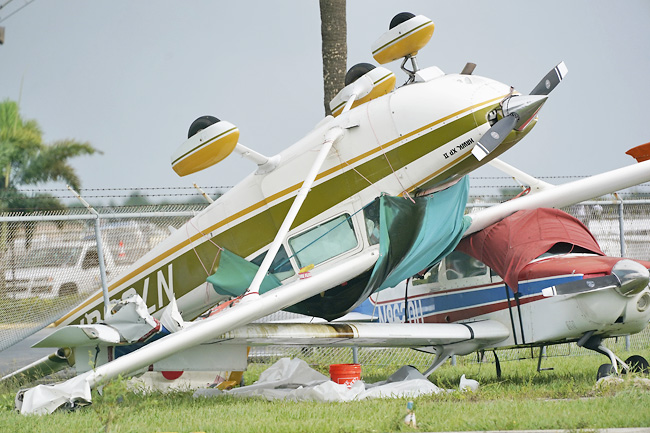AP – Hurricane Ian left a path of destruction in southwest Florida, trapping people in flooded homes, cutting off the only bridge to a barrier island, damaging the roof of a hospital intensive care unit and knocking out power to 2.5 million people as it dumped rain across the peninsula yesterday.
One of the strongest hurricanes to ever hit the United States (US) threatened catastrophic flooding around the state. Ian’s tropical-storm-force winds extended outward up to 415 miles, drenching much of Florida and the southeastern Atlantic coast.
Emergency crews sawed through toppled trees to reach people in flooded homes, but with no electricity and virtually no cell service, it was impossible for many people to call for help from the hardest hit coastal areas where the surge came in.
“Portable towers are on the way for cell service. Chances are your loved ones do not have ability to contact you,” said the sheriff’s office in Collier County, which includes Naples. “We can tell you as daylight reveals the aftermath, it’s going to be a hard day.”
In Lee County, which includes Fort Myers, just south of where Hurricane Ian made landfall, the sheriff’s Office posted a phone number family and friends can call for welfare checks, and said “If the line is busy, keep trying.”

The National Hurricane Center said Ian became a tropical storm over land yesterday and was expected to regain near-hurricane strength after emerging over Atlantic waters near the Kennedy Space Center later in the day, with South Carolina in its sights for a second US landfall.
A stretch of the Gulf Coast remained inundated by ocean water, pushed ashore by the massive storm. “Severe and life-threatening storm surge inundation of eight to 10 feet above ground level along with destructive waves is ongoing along the southwest Florida coastline from Englewood to Bonita Beach, including Charlotte Harbor,” the Miami-based hurricane centre said.
A chunk of the Sanibel Causeway fell into the sea, cutting off access to the barrier island where 6,300 people normally live. How many heeded mandatory evacuation orders was impossible to know in the storm’s immediate aftermath.
In Port Charlotte, the storm surge flooded a hospital’s emergency room even as fierce winds ripped away part of the roof from its intensive care unit (ICU), according to a doctor who works there.
Water gushed down onto the ICU, forcing them to evacuate their sickest patients – some on ventilators – to other floors, said Dr Birgit Bodine of HCA Florida Fawcett Hospital. Staff members used towels and plastic bins to try to mop up the sodden mess.
The medium-sized hospital spans four floors, but patients crowded into two because of the damage, and more were expected with people injured from the storm needing help.
“As long as our patients do okay and nobody ends up dying or having a bad outcome, that’s what matters,” Bodine said.
Law enforcement officials in nearby Fort Myers received calls from people trapped in flooded homes or from worried relatives. Pleas were also posted on social media sites, some with video showing debris-covered water sloshing toward the eaves of their homes.
Hurricane Ian turned streets into rivers and blew down trees as it slammed into southwest Florida on Wednesday with 150 miles per hour winds, pushing a wall of storm surge. Ian’s strength at landfall was Category 4, tying it for the fifth-strongest hurricane, when measured by wind speed, ever to strike the US.
Ian’s centre came ashore more than 100 miles south of Tampa and St Petersburg, sparing the densely populated Tampa Bay area from its first direct hit by a major hurricane since 1921.
Ian dropped to a tropical storm yesterday over land, but was expected to intensify again once its centre moves over the Atlantic Ocean and menace the South Carolina coast.





